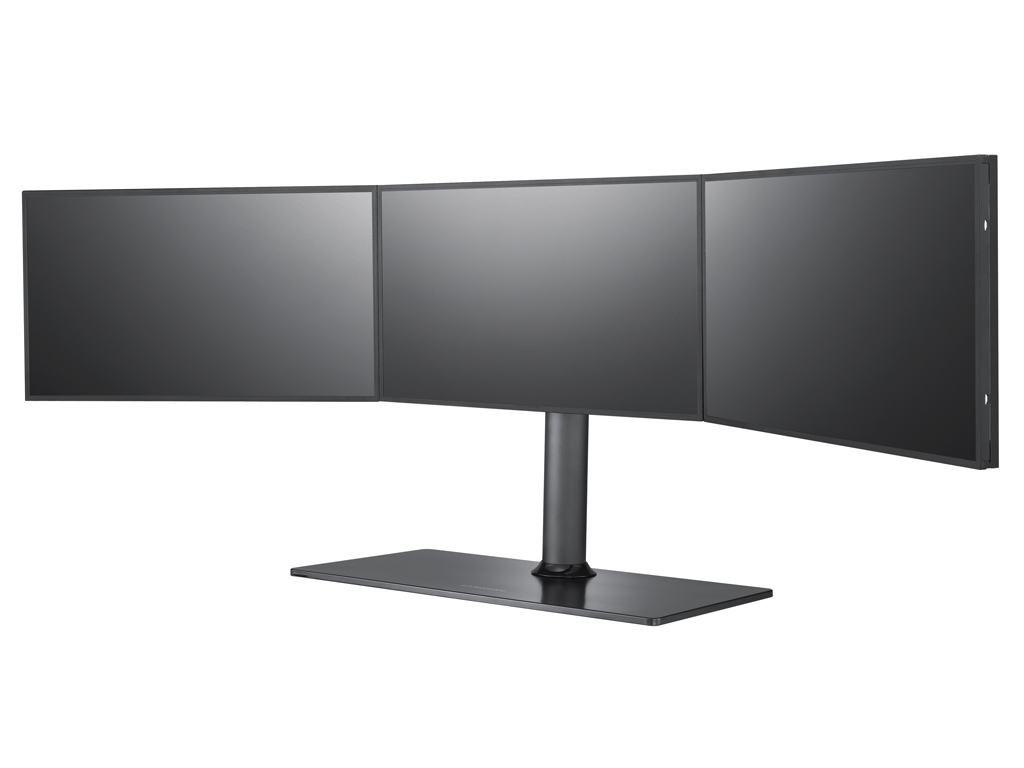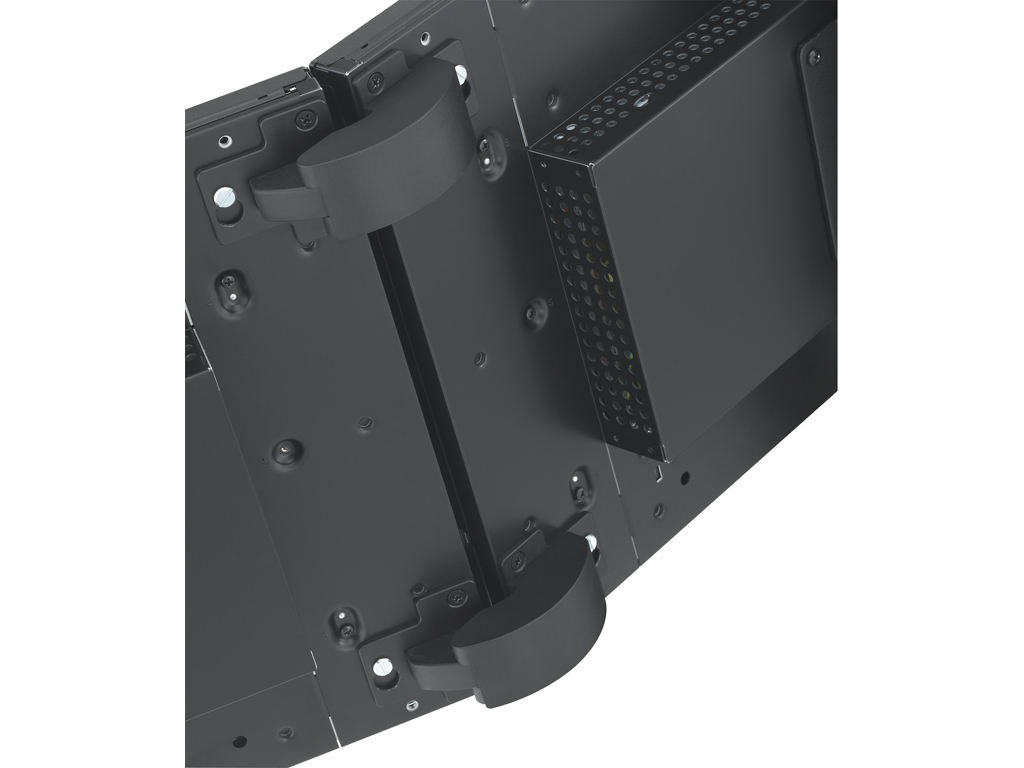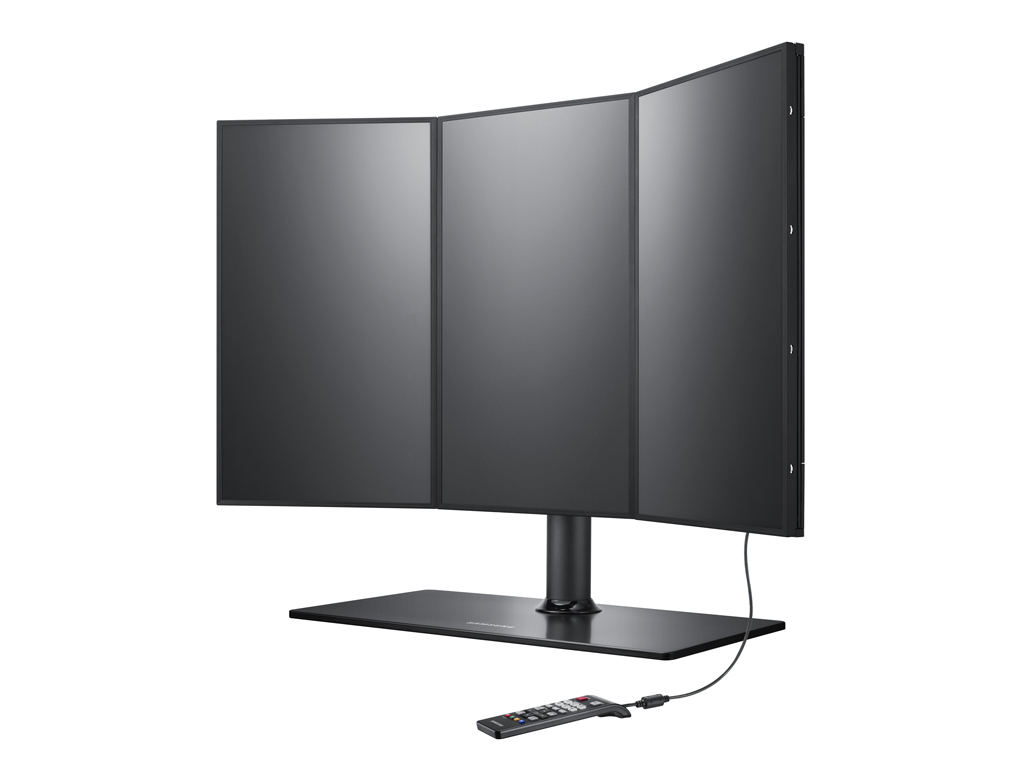Part 2: AMD's Eyefinity Technology Explained
Stands
After getting a grip on its dongles and working to finish its monitor validation program, AMD hasn’t yet been able to give much attention to stands for Eyefinity arrays. Nevertheless, stands are a integral part of any Eyefinity setup. Sure, you don’t require a stand for a 3x1 array, but we know first-hand how easy it is for monitors to get bumped around on the desk and for stand heights to shift over time. It’s annoying. In theory, a stand should keep everything tight, tidy, and elevated to an ergonomically correct height.
Some months ago, we set out to plant three 19" LCDs on an Ergotron adjustable stand—two MAGs and one Samsung. In doing so, we learned a few basic truths about multi-monitor stands. Attaching the hook or clamp to the monitor’s VESA mounting is the easy part. Once the monitors are on the crossbar, that’s when things get tricky. Spacing can be uneven. Angles look off. If you’re a perfectionist, going with a third-party stand and especially when using different monitor makes and models can be a real bear.
No doubt, this is why vendors like Samsung are developing their own stands in-house. In Samsung’s case, the stand is designed specifically for the company’s DisplayPort-enabled MD230 monitors.
“Samsung specifically designed the stand for 3x1 and 3x2 arrangements,” says Gasson. “Having a custom stand for their monitor makes more sense than using a generic stand you can buy off the shelf. It allows the user to set it up so the monitors are perfectly aligned. They just click together with no real adjustments from the user. We would definitely like to see more of that. Third-party stands are definitely not as easy.”
That said, AMD does have some preliminary thoughts for its anticipated stand program. For example, Eyefinity Ready stands would need to be no wider than the width of the panels while Validated stands would feature a “mounting mechanism on the backs of the panels that make it possible to connect the monitors together, so you can adjust them and have them be stable and secure.” You can see this in Samsung’s clever design, which uses a post and notch arrangement along with screws and holes mounted through joined plates.
Factors such as cable management and ergonomic height adjustment are still under discussion for the stand validation program, and there’s no ETA on when the plan might roll out. But in our opinion, it can’t come too soon, because a solid, universal stand spec for multi-monitor could help cut build times in half and make arrays look a lot more professional.
Get Tom's Hardware's best news and in-depth reviews, straight to your inbox.
-
akula2 I use 3 LCDs with 5770 as well as 5850 cards to run many applications simultaneously. Eyefinity feature offers so much and one could easily avoid buying additional PCs by tapping the features from the processor and the graphics card.Reply -
ckim2116 It'd be nice if AMD had their own list of Eyefinity supported games. Some of the games on WGF don't work; in fact, the only games that have worked out perfectly for me have been TF2, Batman Arkham Asylum, Torchlight, and L4D2 (all you have to do is select your resolution in the options, in my case 5760x1080). In other games the menu screen just keeps blinking, and attempting to change the resolution just freezes the game.Reply
Can't wait until all the kinks are worked out! -
cangelini akula2Could someone tell me what happened to the "Print" feature on Tom?Reply
It's right above the comments section, to the right of "Share," amongst a ton of tiny little icons :) -
jsowoc I don't see DisplayPort costing that much more. If I look at 22-24" LCDs, the cheapest they come is around $200 for a TN panel or $300 for a PVA monitor, and about $450-500 for an IPS monitor. It's personal preference whether the quality difference is worth the cost.Reply
If you compare a $200 TN w/out DisplayPort to a $500 IPS w/ DisplayPort, you are comparing apples to oranges. The Amazon price of $220 for a TN w/ DisplayPort is more representative of pricing. -
xrodney I am using 30" dell but only way i can use its native resolution is over DVI, on either HDMI or Displayport maximum of 1920x1200 is possible.Reply
I am not sure if this is limit on DELL only, but as far as I read neither ati 4xxx or 5xxx grapahic card and neither any widely available LCD supports more then that which is quite pitty.
Even more disapointing is that DHCP working only over single DVI link (1920x1200 max) on DELLs and probably others as well. -
1898 Very interesting read, thanks.Reply
ckim2116
From the article: http://support.amd.com/us/eyefinity/Pages/eyefinity-software.aspx -
RazberyBandit Hmm. Landscape-landscape-landscape seems like it would just be sick for gaming. ASUS monitor bezels are actually angled at the top and bottom. When stacked tightly in such an arrangement, they actually wrap around the viewer nicely. Three 24" 16:9 ratio (1920x1080) monitors stacked sideways yields a HUGE 3:2 ratio (3240x1920 resolution) display. Three 16:10 (1920x1200) monitors end up at 3600x1920. I like this idea better than the far more panoramic view of 5760x1080 or 5760x1200 for most games.Reply
Alas, I'll be waiting on the next-gen cards and monitors in hopes that prices drop and availability increases. I'd also like to see the proposed standards mentioned within this article actually go into effect, as well as see adoption of display port grow and the technology itself mature.
Lastly I hope stands adopt a standard that supports landscape-landscape-landscape, portrait-portrait-portrait, and any combination in-between. Having to go out and buy 3 cheap VESA mounts, some metal tubing and round-bar, then get to cutting, bending, and welding my own stand together sounds like a fun project, but I'd rather just buy a mass-produced one.
Edit: I meant portrait-portrait-portrait... -
gaborbarla Bought a 5870 HD the other day.Reply
Two questions remain for me that I couldnt filter out from these articles by skimming through them:
1. Why do we need a display port again? I thought the whole point of HDMI was to introduce a digital standard that works with everything TVs Digital signal processors, PCs. Now that most monitors, graphics cards and even some motherboards are starting to support HDMI they come out with a new format... (dot dot dot)
2. Why does the 5800 series need a display port? why couldn't it have 3 DVI-Ds? So far I haven't even seen a single monitor that has displayport.


